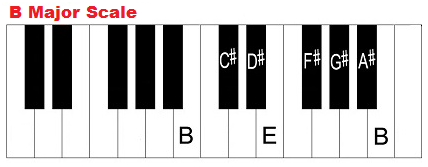The notes of the B major scale are B – C# – D# – E – F# – G# – A# – B. The note, B repeats one octave higher. Its key signature has five sharps.
Intervals of the Scale
- Tonic: B
- Major 2nd: C#
- Major 3rd: D#
- Perfect 4th: E
- Perfect 5th: F#
- Major 6th: G#
- Major 7th: A#
- Perfect 8th: B
My #1 Recommendation: Go here to learn about the BEST piano/keyboard course I’ve seen online.
Piano diagram showing the notes of the B major scale:
Scale Degrees
- Tonic: B
- Supertonic: C#
- Mediant: D#
- Subdominant: E
- Dominant: F#
- Submediant: G#
- Leading tone: A#
- Octave: B


Video:
To construct a major scale, you can use the formula, W-W-H-W-W-W-H. “W” stands for whole step and “H” stands for half step. A half step (also called a semitone) is the shortest interval in Western music. On piano, the distance from one key to the key that is closest to it is a half step. For example, D# to E is a half step. A# to B is also a half step. A whole step (also called a whole tone) is made up of two half steps. B to C# is a whole step. C# to D# is a whole step. On piano, a whole step always skips a key.
To form the B major scale, you start on B, move one whole step to C#, a whole step to D#, a half step to E, a whole step to F#, a whole step to G#, a whole step to A# and a half step to B.
B Major Scale Fingering
What’s the fingering for this scale? It’s as follows:
- Notes: B, C#, D#, E, F#, G#, A#, B
- Fingerings (Left Hand): 4, 3, 2, 1, 4, 3, 2, 1
- Fingerings (Right Hand): 1, 2, 3, 1, 2, 3, 4, 5
(Thumb is finger 1, index finger is finger 2, middle finger is 3, ring finger is 4 and pinky finger is 5.)
What are the triad chords in the key of B major? They are as follows:
- Chord I: B major. Its notes are B – D# – F#.
- Chord ii: C# minor. Its notes are C# – E – G#.
- Chord iii: D# minor. Its notes are D# – F# – A#.
- Chord IV: E major. Its notes are E – G# – B.
- Chord V: F# major. It’s notes are F# – A# – C#.
- Chord vi: G# minor. Its notes are G# – B – D#.
- Chord vii: A# diminished. Its notes are A# – C# – E.
Diatonic Triads In key of B major: B – C#m – D#m – E – F# – G#m – A#dim
All about the key of B major: triad chords, sevenths, notes, scale and key signature.
The relative minor of B major is G# minor. The relative minor of a major key is based on the 6th note of the major scale.Major scales and their relative minors share the same notes. The notes of the G# minor scale are: G# – A# – B – C# – D# – E – F# – G#.
Modes of the B major scale:
- Ionian/Major Scale: B – C# – D# – E – F# – G# – A# – B
- Dorian: C# – D# – E – F# – G# – A# – B – C#
- Phrygian: D# – E – F# – G# – A# – B – C# – D#
- Lydian: E – F# – G# – A# – B – C# – D# – E
- Mixolydian: F# – G# – A# – B – C# – D# – E – F#
- Aeolian/Natural minor scale: G# – A# – B – C# – D# – E – F# – G#
- Locrian: A# – B – C# – D# – E – F# – G# – A#
Major and Minor Scales in All Keys
How To Form Major, Minor, Chromatic, Pentatonic, Blues, Whole Tone Scales & More
Piano Keyboard Lessons Home Page